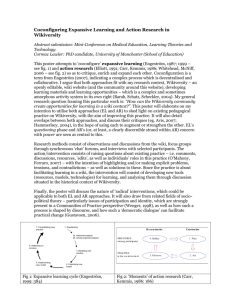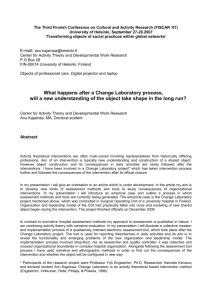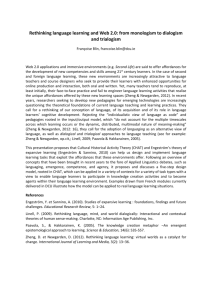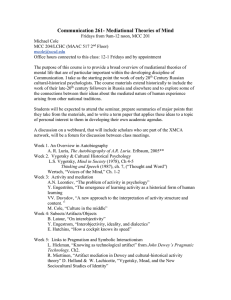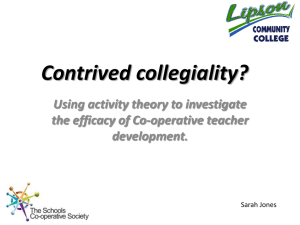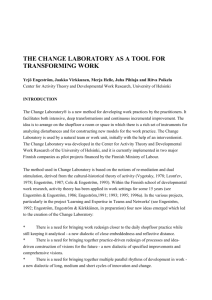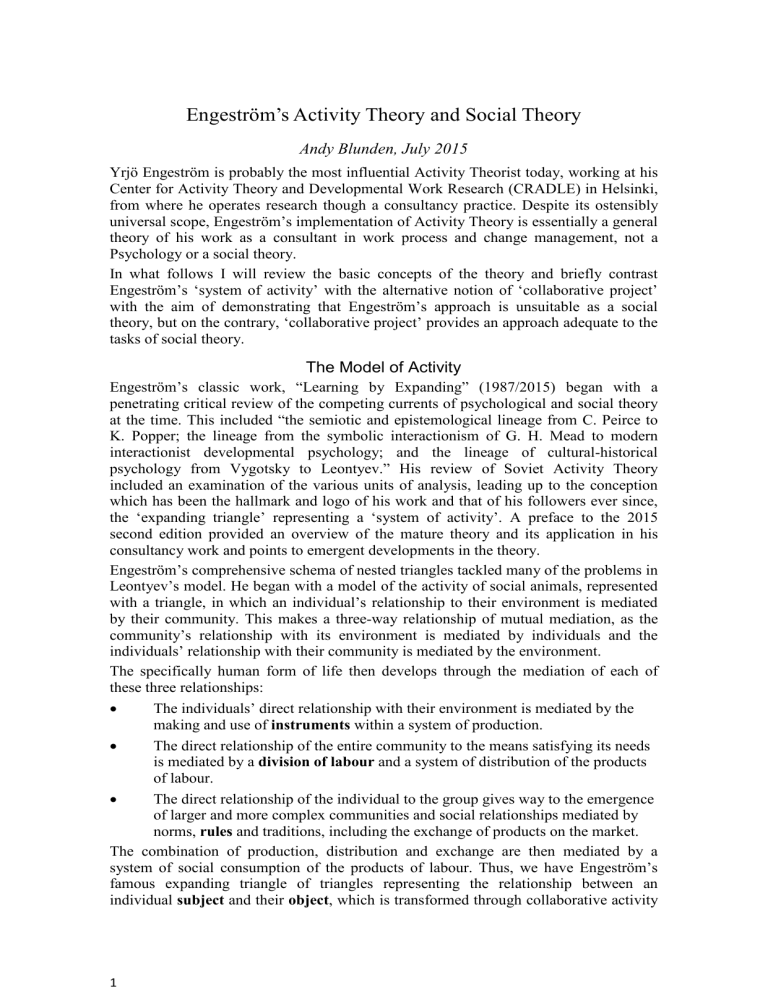
Engeström’s Activity Theory and Social Theory Andy Blunden, July 2015 Yrjö Engeström is probably the most influential Activity Theorist today, working at his Center for Activity Theory and Developmental Work Research (CRADLE) in Helsinki, from where he operates research though a consultancy practice. Despite its ostensibly universal scope, Engeström’s implementation of Activity Theory is essentially a general theory of his work as a consultant in work process and change management, not a Psychology or a social theory. In what follows I will review the basic concepts of the theory and briefly contrast Engeström’s ‘system of activity’ with the alternative notion of ‘collaborative project’ with the aim of demonstrating that Engeström’s approach is unsuitable as a social theory, but on the contrary, ‘collaborative project’ provides an approach adequate to the tasks of social theory. The Model of Activity Engeström’s classic work, “Learning by Expanding” (1987/2015) began with a penetrating critical review of the competing currents of psychological and social theory at the time. This included “the semiotic and epistemological lineage from C. Peirce to K. Popper; the lineage from the symbolic interactionism of G. H. Mead to modern interactionist developmental psychology; and the lineage of cultural-historical psychology from Vygotsky to Leontyev.” His review of Soviet Activity Theory included an examination of the various units of analysis, leading up to the conception which has been the hallmark and logo of his work and that of his followers ever since, the ‘expanding triangle’ representing a ‘system of activity’. A preface to the 2015 second edition provided an overview of the mature theory and its application in his consultancy work and points to emergent developments in the theory. Engeström’s comprehensive schema of nested triangles tackled many of the problems in Leontyev’s model. He began with a model of the activity of social animals, represented with a triangle, in which an individual’s relationship to their environment is mediated by their community. This makes a three-way relationship of mutual mediation, as the community’s relationship with its environment is mediated by individuals and the individuals’ relationship with their community is mediated by the environment. The specifically human form of life then develops through the mediation of each of these three relationships: • The individuals’ direct relationship with their environment is mediated by the making and use of instruments within a system of production. • The direct relationship of the entire community to the means satisfying its needs is mediated by a division of labour and a system of distribution of the products of labour. • The direct relationship of the individual to the group gives way to the emergence of larger and more complex communities and social relationships mediated by norms, rules and traditions, including the exchange of products on the market. The combination of production, distribution and exchange are then mediated by a system of social consumption of the products of labour. Thus, we have Engeström’s famous expanding triangle of triangles representing the relationship between an individual subject and their object, which is transformed through collaborative activity 1 into the outcome. The relationship Instruments between the individual subject and their object is now subject to multiple lines of mediation. Each implementation of this schema Subject Object Outcome produces an outcome which is a changed relationship of all the factors, and each of the mediating links contains contradictions, the mediation of which generate further Rules Community Division of Labor lines of development. The satisfaction of the needs of individuals provides the motor of individual activity, but now in a highly mediated arrangement. Engeström refers to this schema as a ‘root model of human activity’, but in the Second Edition, he confirms that the model was always intended as a ‘unit of analysis’. To describe this schema as a ‘unit of analysis’, however, is to radically misunderstand the method, stretching back through Vygotsky. Marx and Hegel to Goethe. Engeström’s derivation of this ‘root model’ is introduced by specifying four criteria: “First, activity must be pictured in its simplest, genetically original structural form, as the smallest unit that still preserves the essential unity and quality behind any complex activity. Second, activity must be analysable in its dynamics and transformations, in its evolution and historical change. No static or eternal models will do. Third, activity must be analysable as a contextual or ecological phenomenon. The models will have to concentrate on systemic relations between the individual and the outside world. Fourth, specifically human activity must be analysable as culturally mediated phenomenon. No dyadic organism-environment models will suffice” (1987). All of these criteria refer to the model as if it were the subject of analysis, not a unit of analysis. Engeström’s criteria read like the checklist one draws up when packing for an overseas trip, listing everything that will be needed for the journey and then packing them into a suitcase. But the point is to form a concept of a simple entity which is given to the senses and whose potentialities can be grasped viscerally, and from which will unfold a larger, more complex process which is the subject of analysis. The method of analysis by units is used to analyse the larger, complex process on the basis that the larger process is just thousands and thousands of such units and essentially nothing else. In order to understand how the larger process arises we must analyse the unit, but analysis comes of the unit comes after we have formed an abstract concept of it. The expanding triangle does not make us any the wiser about what an activity ‒ a unit of activity ‒ actually is. Generally speaking the concept which forms the foundation of a science, its basic unit and germ cell is an ‘intersection’ between two different processes or some new quality which is introduced into a pre-existing process. For example, Marx (1867) conceived of bourgeois society as essentially a market, functioning within a producing and consuming community. The unit of a market is the single exchange, embodied in a commodity (Marx 1867a). As an object of consumption a commodity is something useful and as a product of labour, valuable ‒ a unity of use-value (a quality) and an exchange-value (a quantity). This follows from analysis of the concept of a commodity, 2 but analysis depends on the fact that the concept of ‘commodity’ is in itself immediately comprehensible. Altogether, Engeström’s model represents relationships between an individual (subject), their object and the outcome, the community, the environment of the system, the social rules, the instruments of production, the division of labour, and the processes of production, distribution, exchange and consumption. These are clearly products of the analysis of an already-existing concept of an activity, but what is this concept? Engeström has confused analysis of the concept of an activity into its own elements with constitution of the concept as a unit of a more complex process. After drawing the nested triangles, he still leaves us with the question: what is an activity? Engeström said that: “Activity Theory has a strong candidate for such a unit of analysis, in the concept of object-oriented, collective and culturally mediated human activity, or activity system” (Engeström 1999, p. 9). By observing how Engeström uses the concept, we can see that in any given consultation, the client’s organisation is the ‘system of activity’; this might be a software company, an aged-care home, a merchant bank, or whatever. Working out what is the division of labour, the relevant community, etc., etc., comes afterwards, as part of the system analysis. He conceives of an activity as a system. I am not aware that Engeström has ever given an explanation or definition of what is meant by ‘system’, but a system is commonly understood as a finite set of interacting and interdependent elements (subject, object, instruments, etc.) forming an integrated whole, delineated by boundaries, surrounded by and interacting with an outside environment, and characterised by its structure and ‘purpose’ (though this last aspect is problematic). That definition leaves open a number of further questions. Is an activity system for some purpose, and if so, what is the nature of that purpose, is it fixed and how is it determined and by whom? How does activity theory deal with the interactions between the system and its environment, and how do we determine the boundaries of the system? What is it about the system of activity which constitutes it as a system and not just an arbitrary aggregate or heap of actions? Indeed, is the system of activity made up of actions or of individual people; is it an activity or a group? These questions are taken for granted by Engeström, but are settled if we accept the definition as the contracting organization. However, what we are left with is Systems Analysis, cutting-edge for 1987, but not the method of Goethe, Hegel, Marx and Vygotsky. Although constantly referred to as a ‘unit of analysis’, the ‘system of activity’ is evidently not a unit of a larger, more complex process, but rather a conception of the entire subject matter as a system. It is its separability and relative independence from its environment which marks it as a system, a finite subject matter for analysis, with relatively defined boundaries. Contrariwise, an activity, a unit of activity, is a unit of an entire social formation in which there are very many such activities, and understanding the movement of that social formation and its parts entails principally understanding the life cycle of the units (how they come into being and transform into something else) and how they interact with one another. That is analysis by units. Systems analysis is doubtless very useful, but it cannot do what analysis by units does. If the subject matter is just the client’s organisation and the units are actions of some kind then systems analysis maybe quite appropriate. But one cannot pretend that this is the foundation for the study of the 3 phenomena of social life as a whole. The social life of a nation-state, for example, cannot usefully be represented as a system of activity; much as the government and public service may wish to squeeze national life into the framework of a system, it does not fit. And though one might suggest that national life is made up of organisations like those who of Engeström’s clients, this simply does not square with reality. Social life is constantly in flux, being constantly made and remade by a wide range of agencies. We learn from the 2015 preface that even the situation of a system of activity can be more complicated than at first represented: we have ‘knot-working’ where the client’s organisation is inextricably tied up with other organisations, ‘runaway objects’ such as the climate change debate or the refugee crisis, ‘wild-fire’ activities where people spontaneously respond to a situation and enter into unplanned collaborative activity, and in a 2015 journal article (2015a), he ventured into social movement theory. The intention does seem to be to tackle these wider problems, but always with the hope of being able to isolate for analysis a finite, bounded ‘system’ of activity. According to the preface, this activity theory “tackles multiple interconnected activity systems and their partially shared and often fragmented objects.” Were it only so! Systems theory is not geared up to deal with anything beyond a pair of coupled systems, but the whole point of analysis by units is to cope with complex systems which entail very large numbers of such units and which defy systems analysis. The conception of such units is therefore necessarily simple, so deploying 11 independent and qualitatively different categories for each unit in large numbers is not a method of analysis at all. The more so given that it is conceivable that systems of activity would have shared and overlapping divisions of labour, communities, objects, subjects, etc. Leontyev’s Activity Theory held out the promise of a social theory to build on and complement Vygotsky’s Cultural Psychology. That is, a theory which could analyse social problems, crises and transformations affecting nation states or at least whole communities, and ultimately the world – social life with all the phenomena found in it – markets, depressions, wars and revolutions, epidemics and plagues, moral panics, technological transformations, population movements, etc. For such a job science does need a unit at the ‘meso-level’, the smallest entity which manifests the essential character of social life, which generates social life and makes up all the formations to be found there. The unit must be something at an intermediate level between the individual and the world. Engeström chose the organisation, conceived of as a ‘system of activity’. But the implications of this choice are an incapacity to deal with all those issues which Engeström raises in respect to knot-working, wildfire activities and runaway objects. Systems analysis is for relatively self-enclosed, finite and functionally stable systems with a well-defined purpose. It is no good for social theory. Further, if Engeström wants to analyse a client’s organisation by the method of units, rather than systems theory, then what this would entail is forming a concept, not of organisations in general, but of the specific organisation which is the subject of analysis, to encapsulate what it is, where it came from, where it is going and what it is for, and discover the simplest action which embodies that activity; from that action, an analysis could be unfolded. Nowadays corporations try to do this with their “mission statements” and so on, but because they know only abstract thinking, all these missions statements end up with the same meaningless empty words. Saying: “We are a system of activity” is hardly an improvement! In what follows, I shall briefly interrogate the particular concepts in Engeström’s theory, but I don’t doubt that he runs a perfectly effective consultancy practice using 4 this theory. The difficulties I raise evidently do not prove to be obstacles in this work. But they do demonstrate obstacles in front of using the ‘system of activity’ as a unit of analysis for social theory. The Subject of Activity Engeström’s Activity Theory does not claim to look into people’s minds, although Engeström says that preliminary phenomenological work is needed before the analysis as such begins, to gauge people’s expectations, motivation, etc. As throughout the CHAT tradition, psychological phenomena are studied and described explicitly through a person’s actions. The Subject is an individual at some location in a given Activity System. It is always the same system, but the place of Subject can be taken by one or another role within the system, and the problems and tasks arising for and the actions taken by that role are observed. The theory thus takes the standpoint of one or another role, in order to analyse the system from multiple points of view within the system. By analysis of actions, the approach “tackles issues of subjectivity, experiencing, personal sense, emotion, embodiment, identity and moral commitment” (p. xv-xvi, 2015). But only within the limited context of the client’s organisation. A participant’s other commitments ‒ education, family, etc. ‒ are outside the frame; only their actions within the activity system are in the frame. So ‘subject’ refers to individuals and no kind of collective subject, and not even a whole individual, since the individual is an agent only insofar as they are acting within the system of activity. Even though the Object is an object for the whole system, the Subject is an individual who apparently shares that Object with others within the system. Were we to take Activity Theory as developed by Yrjö Engeström as a social theory, then there is no Subject – the Object is given and the subject’s concerns are confined to their role within the organisation. But the theory is not a social theory. The Object of Activity What motivates the Subject then? All the subjects in a system have the same Object, but their relation to the Object will be mediated according to their location within the system. The Object is the most problematic and Janus-faced node in the system. For Engeström, the object of activity is defined as follows: “The subject refers to the individual or sub-group whose agency is chosen as the point of view in the analysis. The object refers to the ‘raw material’ or ‘problem space’ at which the activity is directed and which is molded and transformed into outcomes” (CAT&DWR, 2003) So this appears to be a very specific concept of object, more specific than Gegenstand, quite different from Leontyev’s predmet (the imagined and desired objective outcome), though close to the German Arbeitsgegenstand (the object worked upon). The difference is that for Engeström “The object carries in itself the purpose and motive of the activity” (2015a, p. 92). So at first, we see that the object (Arbeitsgegenstand) is categorically different from both the desired outcome (predmet) and the (actual) outcome, in that it is an immediately given entity, neither something of desire nor of the future. The Arbeitsgegenstand may be transformed into the desired outcome, but also it may not be. So where does the motivation for the subject figure in this, and what are the psychological consequences of intended and unintended consequences, given that the 5 intention did not figure in the system of activity at all? Engeström’s answer is that the purpose and motive of the activity is carried within the object in the form of a ‘problem space’; the problem is implicit in the Arbeitsgegenstand. So for example, if a medical clinic has for its object an ill person, the motive is to cure the patient of the illness. As a result of the activity, the object is changed, and this changed object is called the ‘outcome’. We know nothing, however, of the change in the subject resulting from the outcome, whether intended or unintended. The subject remains unaffected, and the psychological issues flowing from a subject achieving or failing to fulfil their aims is out of the frame. So analysis of systems of activity is unsuitable as an approach to Psychology. The Purpose of an Activity From the point of view of the consultant and their client there is nothing problematic in the idea of the object being a ‘problem space’. But from a wider perspective, in which there are many competing possible ‘clients’, it is very problematic. For example, People With AIDS rejected the definition of their condition by the medical establishment and fought for the right to be included in research, the Women’s Health Movement challenged the way women’s bodies were cast in the health system and the Gay Rights Movement still struggles against the view that homosexuality is an illness. The definition of the problem is inseparable from the means of solution. For a man with a hammer the object is a nail, for the surgeon something needs to be cut out, for the pharmacist, a drug needs to be prescribed. From the standpoint of social theory, the rival concepts of a problem and thus the rival means of resolving it, are the key elements of the complexity of social life to be analysed. In Engeström’s Activity Theory this key element of social life is invisible. A social theory requires an analysis of the aims of the subjects and the means they adopt to achieve their aims. The subjects here, if there are any at all, are the clients, and the client, who determines the object of the system of activity lies outside the frame. The Boundary Object Susan Leigh Star introduced the concept of ‘boundary object’ in 1989 as an “arrangement that allow[s] different groups to work together without consensus” (Star, 2010, p. 602). In social theory this would mean the judicial, political, administrative, educational and welfare systems in the country, but the concept of boundary object would be redundant here because no social theorist would be naïve enough to think that these institutions are ‘neutral’; they are simply the armistice arrangements put in place to settle past struggles. To the typical client of a consulting firm however, this is by no means obvious, and ‘boundary object’ indicates this in terms of Arbeitsgegenstände which are construed differently by different subjects in a collaborative project involving a number of organisations, possibly under the illusion that everyone sees it the same way. Engeström deploys this term to indicate the shared Arbeitsgegenstand. However, in the meaning given to the term by Star, there is no suggestion at all that the aims and purposes of a collaborative project are carried within the taken-for-granted infrastructure. For Star the ‘boundary object’ was not an Arbeitsgegenstand to be transformed into an Outcome, and the ‘boundary object’ carries within it purposes and aims of historical struggles which lie outside the collaboration. The scenario in which two or more ‘systems of activity’ share the same Arbeitsgegenstand and either 6 cooperate or conflict over what to transform it into is an important one, and I see no harm in deploying the term ‘boundary object’ to indicate it. For there to be any significant relation between two subjects there must be a shared Arbeitsgegenstand. But in social theory one hardly needs a special name for it. In a 2015 paper, Engeström (2015a) deployed the term in yet a different sense. In this paper he moved away from consideration of ‘systems of activity’ and considered social movements and individual subjects. Among other things, the paper demonstrated how ill-equipped was the theory developed for work process and change management consultancy for social theory. One symptom of this was that Engeström had to give ‘boundary object’ a new meaning: a symbol with which the subject is identified in a neutral or derogatory sense, which is transformed through its use by the subject in order to transform and strengthen its identity. This caused Engeström to ask whether the ‘boundary object’ was a communicative instrument or an object? A problem of ‘pin the tail on the donkey’ the like of which many of his followers have encountered over the years! The fact is that the concept of a ‘system of activity’ is ill-equipped to deal with such situations; ‘knot-working’ is about the outer limit of its usefulness, and social movements are a step too far. The idea of the contested signifier is a useful one, but it has no place in the ‘expanding triangle’. Concept Formation Engeström’s work (1999, 2012) on ‘interactive design’, which brings ‘germ-cells’ to centre-stage rather than the activity system, is to my mind the most interesting part of Engeström’s work, and one which has applicability beyond the bounds of the ‘activity system’. Here the approach is built from a ‘contradiction’ which has arisen somewhere within the activity system. A concept of a solution emerges in the form of a germ-cell, and can be developed into a satisfactory, concrete solution. However, the theory is still undeveloped. The ‘epistemic actions’ sketched in 1999 (pp. 383-4) were still much the same in 2012 (p. 289), but the schema is problematic. For instance, the process by means of which the germ-cell – the ‘simplified model of a new idea’ – is first determined, is under-specified and important elements of the concept formation which follows are absent: 1. “The first action is that of questioning, criticizing, or rejecting some aspects of the accepted practice and existing wisdom. ... 2. “The second action is that of analysing the situation. Analysis involves mental, discursive or practical transformation of the situation in order to find out origins and explanatory mechanisms. 3. “The third action is that of modelling a new explanatory relationship in some publicly observable and transmittable medium. This means constructing an explicit, simplified model of the new idea, a germ cell, that explains the problematic situation and offers a perspective for resolving and transforming it.” 4. “The fourth action is that of examining the model, running, operating, and experimenting on it in order to fully grasp its dynamics, potentials, and limitations. 5. “The fifth action is that of implementing the model, concretizing it by means of practical applications, enrichments, and conceptual extensions. 6. “The sixth and seventh actions are those of reflecting on and evaluating the process and consolidating its outcomes into a new stable form of practice.” Missing from this schema are (a) the stimulus, (b) misconception and (c) the role of objectification, and (d) there is no basis for presuming that the new form of practice will 7 be stable and not set off a new round of innovation rather than consolidate, and (e) proliferation. Engeström conceives of these problems arising from a ‘contradiction’ at one of another location and level within the activity system. But in fact, the conception as described is quite independent of the triangular model of the activity system: social change does emerge from problems arising within some institutionalised system of activities, whether at the level of an organisation or at the level of a nation state or wider. For social theory, the germ-cell process is what is interesting, not the ‘expanding triangle’. (a) The stimulus to criticise some aspect of the system is missing. Undoubtedly it exists within the consultancy practice, and arises as the result of an intervention, but this is not at all the usual way that social problems come to notice. Usually it is the suffering subjects themselves who speak up and through their speaking up come to recognise each other as part of a shared project. The collective is not given in advance, and its formation is an important part of the issue. (b) Misconception. When a contradiction or some unmet need arises more than one solution is usually posited. In the case of very fundamental problems it is normally the case that most proposed solutions actually fail because they interpret the problem in terms which simply reformulate the problematic arrangement itself. A sustainable and satisfactory resolution of a problem usually arises from criticism of misconceptions, though more often than not it is misconceptions that continue on through the process described by Engeström, and possibly re-appear as problems after the consultancy has finished. ‘In the wild’, one would expect multiple rival conceptions of the problem to compete, and neglecting the very possibility of misconceptions is a serious error. (c) Objectification. It is not enough to find a solution which works within the bounds of the community where it arose. That community changes over time and is connected with other communities by a thousand threads; people forget, people get different priorities, people move on and new pressures arise. Unless a new solution is written into regulations, built into infrastructure and embedded in the wider community it will most likely disappear over time. Mike Cole et al’s (2014) experience of 30 years of 5thD programs confirms this. But even more importantly, the struggle to objectify a new social practice turns out to be a difficult and highly productive epistemic cycle in itself, which brings to light aspects of the proposal which were previously unseen. (d) While it may be implicit in what Engeström wrote, all of these stages and the cycle as a whole will be recapitulated indefinitely. (e) The proliferation to different organisations is, like objectification, not only an essential part of consolidating a new social practice, but turns out to be a difficult, rich and important phase of innovation, as the idea which was implemented in one set of circumstance fails in others and has to be modified, bringing out successively what was essential and what was contingent in the original idea, contributing to the formation of a new concrete concept. (See Blunden 2014.) These issues go beyond the bounds of the consultant’s contract with the client and in some cases beyond the bounds of the client organisation, but from a social theoretical point of view they are crucial. History is full of failed or forgotten reforms and understanding how and why some innovations survive and grow while others fade away is the central problem of social theory, and the ‘expanding triangle’ is no help here. The contortions into which the theory of the activity system enters when it tries to tackle the infinite interconnection of organisations (let alone their birth and death) and 8 unbounded social movements and persistent social problems is testimony to this. It is no good just saying “Human activity is a complex systemic formation” (2015 2ed). No-one says that social theory demands an all-embracing systemic schema. What is needed is a unit of analysis, and the ‘system of activity’ is unsuitable for analysing and intervening in social life “in the wild.” Systems of Activity and Projects I claim that ‘project’ is a unit of analysis of activity which is suitable for use in social theory. The differences between a project and a system of activity are as follows: (a) A project has no boundaries. This is mainly because a project is composed of actions not individual people. This is in line with Leontyev’s Activity Theory and Vygotsky’s Cultural Psychology which are based on artefact-mediated actions. All the actions which are subsumed under the object-concept of the project are realisations, under particular conditions, of the object-concept ‒ that concept which fixes the object or purpose of the project which is its motive force. There is no location or person who can be excluded from participating in a project. This contrasts with a ‘system of activity’ which is in reality a ‘system of roles’ whereas the social and psychological purchase of the idea of projects depends on it being an aggregate of artefact-mediated actions. (b) A project has a life cycle which begins when some category of people meet some problem, injustice or an opportunity of some kind and devise a solution. This may turn into a social movement identifying itself with a concept whose realisation would negate the problem-situation; under criticism, this concept undergoes continual modification until a new object-concept is finally institutionalised; that is, the social movement becomes an institution, or ‘system of activity’, which in turn interacts with and merges with other projects. The object-concept of the project enters the language. At some point, after the institution has merged invisibly into the entire way of life of the community, conditions will change and it will fade away, preserved perhaps only by a word in the language and traces in the historical record. Roughly speaking, a ‘system of activity’ is just one phase in the life-cycle of a project. Thus Activity Theory which takes collaborative projects as its unit of analysis studies the life-process through which the institutions we find in our world come into being and pass away, something which is essential to understanding the world we live in. Understanding the internal dynamics of the components parts of our society is no substitute for understanding the whole life cycle which creates institutions and eventually dissolves them. (c) The object of a project is a desired and imagined objective situation, as it was for Leontyev. I say “imagined objective” because while an imagined situation is something merely subjective, an imagined objective situation depends for its existence also on actions beyond the control of the subject. The Arbeitsgegenstand of a project is generally unbounded and shared. In the instance of limited and derivative projects there is a corresponding particular Arbeitsgegenstand and in the instance of projects collaborating for some object, the shared Arbeitsgegenstand is an important concept. But by no means do I see the object of a project being implicit within the Arbeitsgegenstand. Problematic situations do not generally exist solely within the Arbeitsgegenstand, because very often what makes the Arbeitsgegenstand problematic are wider political, customary and cultural activities, not the Arbeitsgegenstand itself. Even if we take the concept of Arbeitsgegenstand to 9 encompass the ‘problematic situation’, collaborative projects or even individuals participating in a project each have a different concept of the object. The object-concept of the project, that is, the concept which the project has of its object, is both subjective and objective because its existence is implicit in the actions of all participants. Consequently, the object-concept is not fixed, but is under constant criticism and revision. Collaborative projects are both innovation and learning processes. (d) A project is autonomous and creates its own identity. It has no boss. A project cannot be owned or directed. A project is constantly regenerating its object-concept which constitutes its identity. The project’s object-concept is not given to it as part of a self-regulating social organism as it is in functionalist social theory, but is determined autonomously. A project is in fact a subject. Its thoughts and desires those of the individual actors who realise it. Every individual sees things a little differently and the object-concept of the project is implicit in their diverse actions, taken as a whole. (e) The decision-making procedures of a project are of central concern, both internally and from the point of view of analysis. The procedure used, whether majority voting, consensus or by counsel, the definition of who has a right to participate in decisionmaking and the kind of arguments and concepts which count as valid are all derivative of the object-concept of the project, the concept of ‘who we are’ and what we stand for. (f) The personnel of a project is essentially in constant flux, with recruitment and apprenticeship important subjects for analysis. In some cases, people may be employed to work on a project, in other cases, people lend their efforts to a project on a voluntary basis, with or without being conscious of it. Collaborative projects are the normal processes of social life, after all. Conclusion I am not in a position to judge the validity of Engeström’s version of Activity Theory as a general theory of their consultancy practice in work process and change management. A general theory of this kind can function as a receptacle for the wisdom and lifeexperience gained in a life time of varied and exacting interventions. If there is to be a critique of this theory it will have to come from within CRADLE. However, I can say that it is methodologically discontinuous with both Leontyev’s Activity Theory (in respect to its conception of the object and its disciplinary focus) and Vygotsky’s Cultural Psychology (substituting systems analysis for analysis by units). Although Engeström has appropriated and fruitfully applied many of the insights of the tradition of Romantic science (notably the idea of the germ-cell), methodologically speaking it does not belong to this tradition. But the main conclusion is that it is not a suitable approach for social theory, the discipline which takes as its subject matter the phenomena of social life ‘in the wild’ and in its broadest scope, and this is just what Activity Theory which takes collaborative projects as the unit of activity does. References Blunden, A. (2014). The formation of the concept of ‘collaborative learning space’, in Collaborative Projects. An Interdisciplinary Study. Brill. Center for Activity Theory and Developmental Work Research (CAT&DWR) (2003), What are CHAT & DWR. http://www.edu.helsinki.fi/activity/pages/chatanddwr/ 10 Cole, M., Gordon, V. & Blanton, W. (2014). Seeking to Combat Educational Inequality: The 5th Dimension, in Collaborative Projects. An Interdisciplinary Study. Brill. Engeström, Y. (1987/2015). Learning by Expanding. An Activity-Theoretical Approach to Developmental Research. Cambridge University Press. Engeström, Y. (1999) Innovative learning in work teams: analysing cycles of knowledge creation in practice, in: Y. Engeström et al (Eds.) Perspectives on Activity Theory, (Cambridge, Cambridge University Press), 377-406. Engeström, Y., Nummijoki, J. & Sannino, A. (2012), “Embodied Germ Cell at Work: Building an Expansive Concept of Physical Mobility in Home Care,” Mind Culture and Activity,19(3), Philadelphia, PA: Taylor & Francis. Engeström, Y. (2015a). Toward a Grammar of Collaboration, in Mind, Culture, and Activity (22)2, p. 92-111. Marx, K. (1867). Capital, v. 35 MECW. Marx, K. (1867a) Preface to the First German edition of Capital, v. 35 MECW. Star, S. L. (2010). This is not a boundary object: Reflections on the origin of a concept. Science, Technology, & Human Values, 35(5), 601-617. Andy Blunden's Home Page 11
